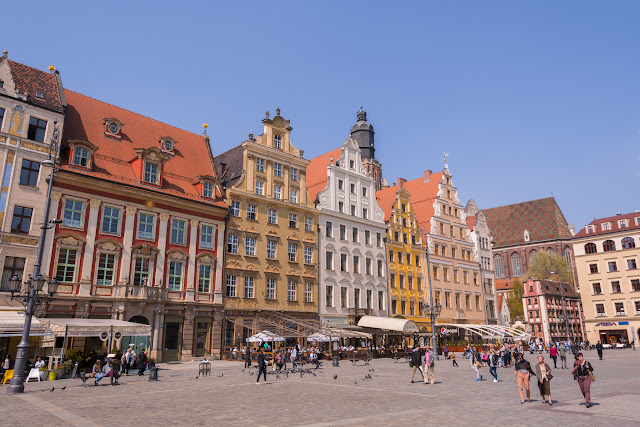But back to Poland. I hopped on a bus in April and cruised from Berlin to the Polish city of Wrocław, where I spent a short couple of hours before continuing on to Krakow. Wrocław, Poland's fourth largest city, feels like more of a humble student town than anything, but it hosts one of Europe's biggest market squares, which is where I spent all of my time. The city belonged to the Kingdom of Poland, Bohemia, Hungary, the Austrian Empire, Prussia and Germany before finally becoming Polish in 1945. Its name is also incredibly difficult to pronounce - phonetically, it looks something like "VROH-ts-wahv." Good luck.
Wrocław has recovered well from World War II, as it was nearly 70% destroyed after the Germans unsuccessfully tried to fight off Soviet attacks for five months in 1945. Let's take a look at how pretty the city center looks these days.
 |
| The market square was first built up in 1241 |
 |
| Remember that all this had to be rebuilt after 1945 |
 |
| The market square's big highlight is the Old Town Hall, built over the course of 250 years starting in the late 1200s |
 |
| Another photogenic square, Plac Solny |
 |
| The giant towers belong to the Cathedral of St. John the Baptist, started in 1244 |
 |
| A church first built in the 1330s. It goes by the mouthful of a name of Church of the Holiest Virgin Maria on Sand |
 |
| A market hall called Hala Targowa |
 |
| The main buildings of Wrocław University, founded in 1670 by the Jesuits |
 |
| Ul. Jatki, where most of the buildings date to the 1600s and 1700s, is one of the city's oldest and most narrow streets |
 |
| Ul. Jatki |
 |
| St. Elizabeth's Church, built in the 1300s but since destroyed and rebuilt three times over |
 |
| After I parted ways with a few Polish złotys, I climbed up the 300 steps up the city's tallest church building to get some fantastic views |
 |
| It may not look like much, but that funky tower is Poland's tallest building, at nearly 700 feet |
 |
| My great view of the market square from above |
 |
| St. Mary Magdelene's Church, built in the 1300s |
 |
| Not many other tourists in here |
Alas, not long after my stay in Wrocław had begun, it was already over. Not to worry - my two American friends and an amazing couple of days awaited me in Krakow. I boarded a Polish train at rode in style to my next destination. There, I met up with Sarah and Kendra, dined on some delicious pierogi, and headed to the city's market square, which is the largest in all of Europe! As I explained to my travel companions that every hour, on the hour, a trumpet player plays a tune from the square's tall church tower, the clock chimed and the sounds of a horn floated over the square - perfect timing, and the perfect start to our stay.
I'll leave the history lessons for next post - check out the photos from my first night there and don't forget to check back for the shots from the rest of the trip!



















